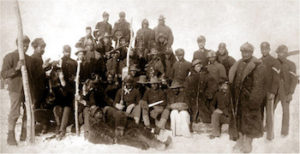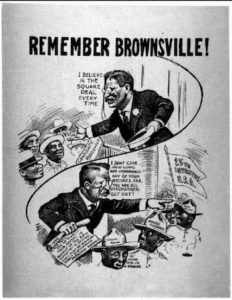
U.S. Armys 167th Infantry (1906)
*The “Brownsville Affair” of 1906 is remembered on this date. This was a racial incident from tensions between whites in Brownsville, Texas, and black infantrymen stationed at nearby Fort Brown in the U.S. Army.
The soldiers had been subjected to racial discrimination since they arrived. A shooting incident in the town on August 13 left a white bartender dead, and a police officer wounded. Although white commanders at Fort Brown affirmed that all Black soldiers were in their barracks at the time of the shooting, local whites claimed that Black soldiers had been seen firing. They produced spent shells from army rifles to support their statements.
Despite evidence that indicated the shells had been planted, investigators accepted the statements of the white community. When the Black soldiers were pressured to name who fired the shots, they insisted they did not know about the shooting. There was no trial, and the men were not given a hearing or the opportunity to confront their accusers. Yet, President Theodore Roosevelt ordered 167 black infantrymen discharged without honor because of their alleged conspiracy of silence.

Some of the men dismissed had over twenty years of service and were only a short time away from retirement with pensions. All security and financial compensation for their previous service was taken away from them. The Black community was furious at Roosevelt's actions, including Booker T. Washington. Although he did not criticize the president publicly, he protested privately; still, Roosevelt dismissed his plea to reconsider. Even some whites criticized the President. A United States Senate committee investigated the episode in 1907-08 and upheld Roosevelt's action.
In 1970, John D. Weaver's THE BROWNSVILLE RAID investigated the incident in-depth, and the writer concluded that the discharged soldiers had been innocent. Sixty-six years later, the army conducted a new investigation and, in 1972, reversed the order of 1906.